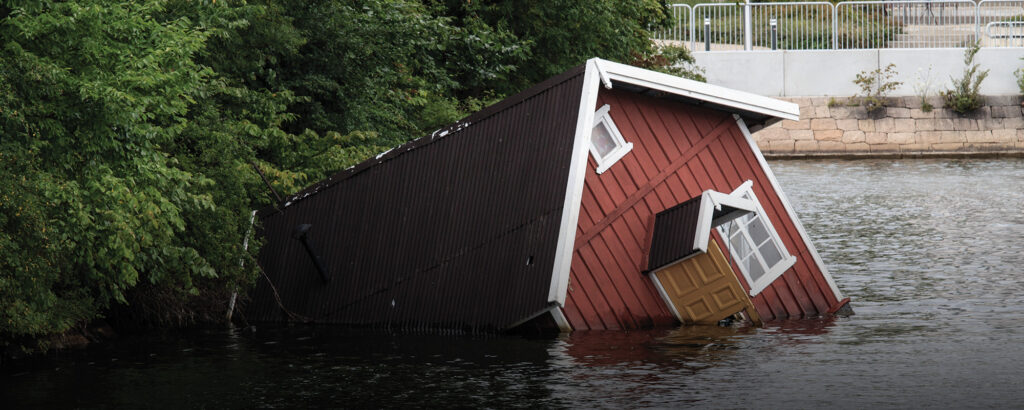
Have you ever been to a lake? Or how about the beach? One look at a majestic body of water and we think, “Wow. How beautiful is that lake?” or “The waves of the ocean are hypnotic.” Certainly, sitting or laying on the shore overlooking the ocean can be a relaxing time. As we ponder the serenity of watching the rolling waves creeping toward the shore, we are also reminded of just how dangerous the waters can be. Water is the essence of life. We need it, and much of it in order to live. But too much water can be equally dangerous. It can consume us and our possession, our property. What I’m talking about is flood waters. Flood waters, or just flooding, can occur in any part of the world, from the deserts of the Mojave to the western European coastal areas, to even entire islands. But the severity and frequency of flood waters damaging your neighborhood are dependent on location, season, elevation, and climate change. In addition, some floods can be attributed to humans, or the failure of humans taking appropriate actions. Dams can burst and inundate towns below. More localized than the others, the bursting of water pipes can overwhelm a homeowner and leave their possessions swimming in municipal water. But let’s go back to our focus which is flooding, the natural and man-made disaster, and how we could survive it.
Preparation
The first element in any survival situation is preparation. Preparation covers steps and measure taken to prevent and protect assets. How much time and resources we spend on preparation will drastically impact how much damages and money is lost. The more we spend on preparation, the lower the probability ourselves and our possessions are at risk of damage. While preparation is very crucial in survival, it is not and should not be the only element considered in surviving disasters. Let’s start with the beginning and if you happen to already be in the middle of the process, no worries! You can always start from the beginning and review your situation, making necessary adjustments based on your decisions. One of the greatest freedoms of people is the right to comfortable living. Whether you prefer to live in a single-family bungalow-style house, a high-rise apartment, a condo, or it a cabin somewhere in the woods, your home is where you will be spending most of your life in. Why should we endanger our lives by being forced to live in an area where hazards exists. While we cannot totally avoid hazards, we can take precautionary measures. Look at the area of where you will claim your net home or your current home. Examine the environment. How close is it to a large body of water? Is my home located in an elevated area or in a low valley? Is my home located near the base of a mountain? Is my home located near a dam? Is my home located on the slope of a hill? Is my home located near a recognized wash? Is my home located on a marsh? All of these factors should be considered when taking residence in your next home. These factors make up what is called “flood zones” or zones specifically designated for flooding potential. Usually when speaking to a realtor, they must inform you of whether the residence is located in a flood zone. You can also find out whether your residence is in a flood zone by going to the FEMA Flood Map tool at: FEMA Flood Map Service Center | Search By Address. The map should inform you if your residence is in aa high risk of flooding, a probable flood zone, or a minimal flood zone. A word of advice, even if your residence is not in a flood zone or in a minimal flood hazard zone, your residence can always be in danger to what is called the 100-year flood. The 100-year flood is the chance for a major flood to occur, given the probability of it occurring 1 out of 100 years. This does not mean that for every 100 years a great flood will occur. what this means is that a flood of a high magnitude has a one percent chance of occurring on any given year. Take a look and research about the 1931 Great China Flood, the 1887 Yellow River Flood, and the 1938 Yellow River Flood in China; all of which occurred within a 100 year time period. If your home is located in a flood zone or a suspected flood zone, you may want to opt in getting flood insurance. Most insurance companies don’t cover or offer flood insurance. This is because floods can happen anywhere and anytime. Just a small amount of flood water can cause up to $25,000 worth of damages. But you can sign up for the National Flood Insurance Program, a program coordinated by FEMA with a network of insurance providers, to assist in providing coverage for flood damages. To learn more, please visit FEMA’s NFIP at Flood Insurance | FEMA.gov. Get the coverage that is right for you! Once you have established whether you need flood insurance or not, the next step focuses on individual/family preparedness. This is a crucial step. Always have a plan and have emergency preparedness kits just in case you are forced to evacuate your home. Your local municipality should be sending you alerts of when a flood watch, flood warning, of flood imminent is expected. In some areas, the customer (you) is responsible to sign up. In other areas, your cellphone provider automatically signs you up, as they are a part of the Integrated Public Alert and Warning System, or IPAWS. To read more, visit the FEMA webpage at Integrated Public Alert & Warning System | FEMA.gov. When you receive a notification of a possible flood, TAKE IT SERIOUS!! Once you receive that notification, prepare yourselves to respond. If you need to evacuate, ensure you have a safe place that all your family members know, in case of separation. Ensure the safe place is in an elevated area, with plenty of vegetation, away from bodies of water, and adequate drainage. If the safe place is too far of a distance, it may be safer to shelter in place. You do not want to be stuck in heavy traffic during a flood. You may also want to consider taking high ground, such as climbing on your rooftop. Just ensure you stay clear of metallic objects and power lines. Bring your emergency kits with you. Your kits should have a minimum of 72 hours worth of clean water and preserved food, sealed in a waterproof container. Always pack items that can provide light, heat, and fire in case you have to cook your own food. Other items to include are signaling items such as an orange marker tarp, flares, whistles, and smoke devices. A first aid kit with all the essentials and prescribed medication should also be included. Batteries are gold and cash is indispensable. There are other essentials according to the season and location and these need to be considered due to excessive weight. Finally, take some time (preferably not during a flood) to practice flood evacuation drills. This will ensure that everyone involved is on the same page and knows what to do. A well-oiled machine operates better when no rust is present. Connect with your local, state, and federal communities to find more resources. And don’t miss part 2 of this blog “Response” coming soon.
Stay frosty!
